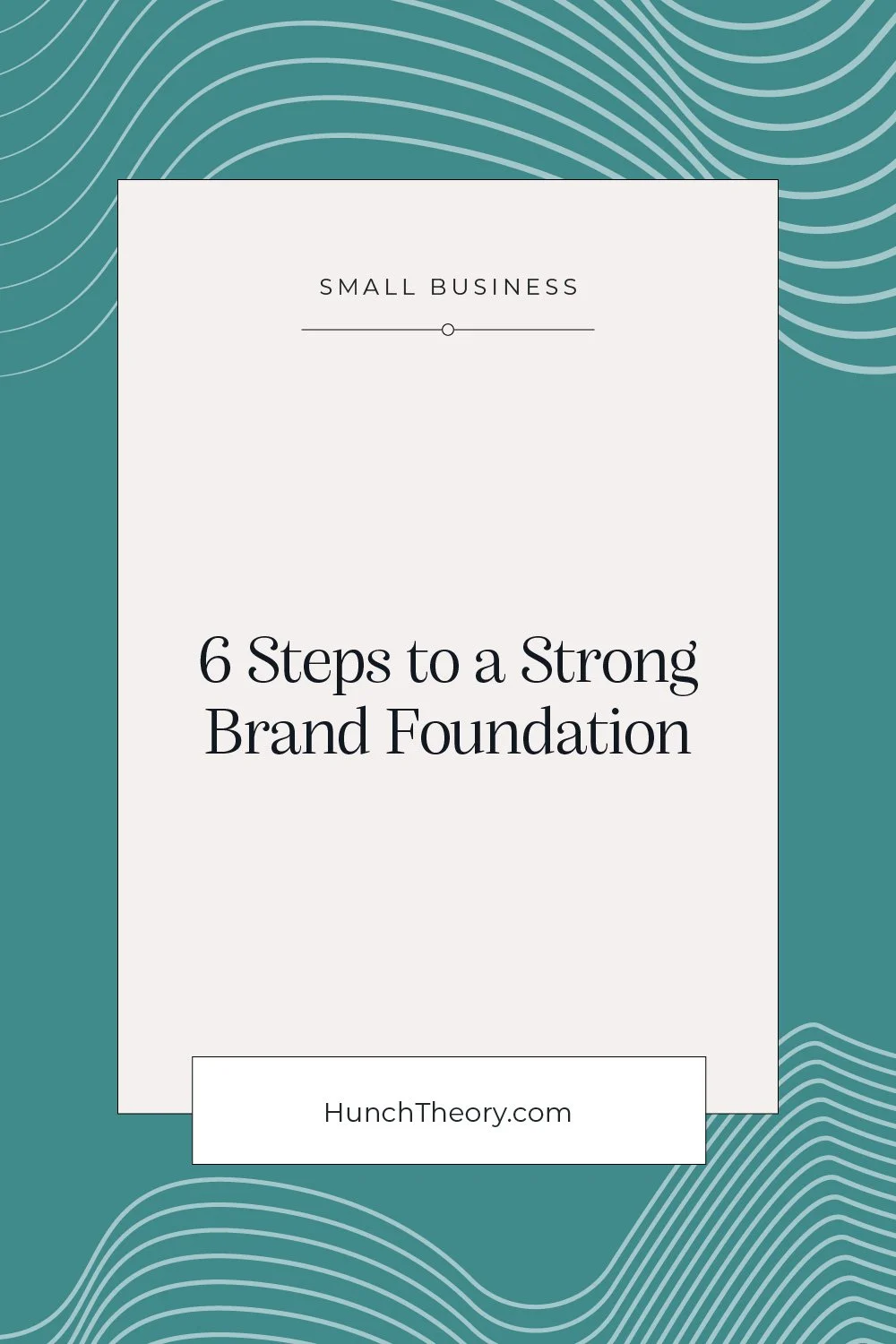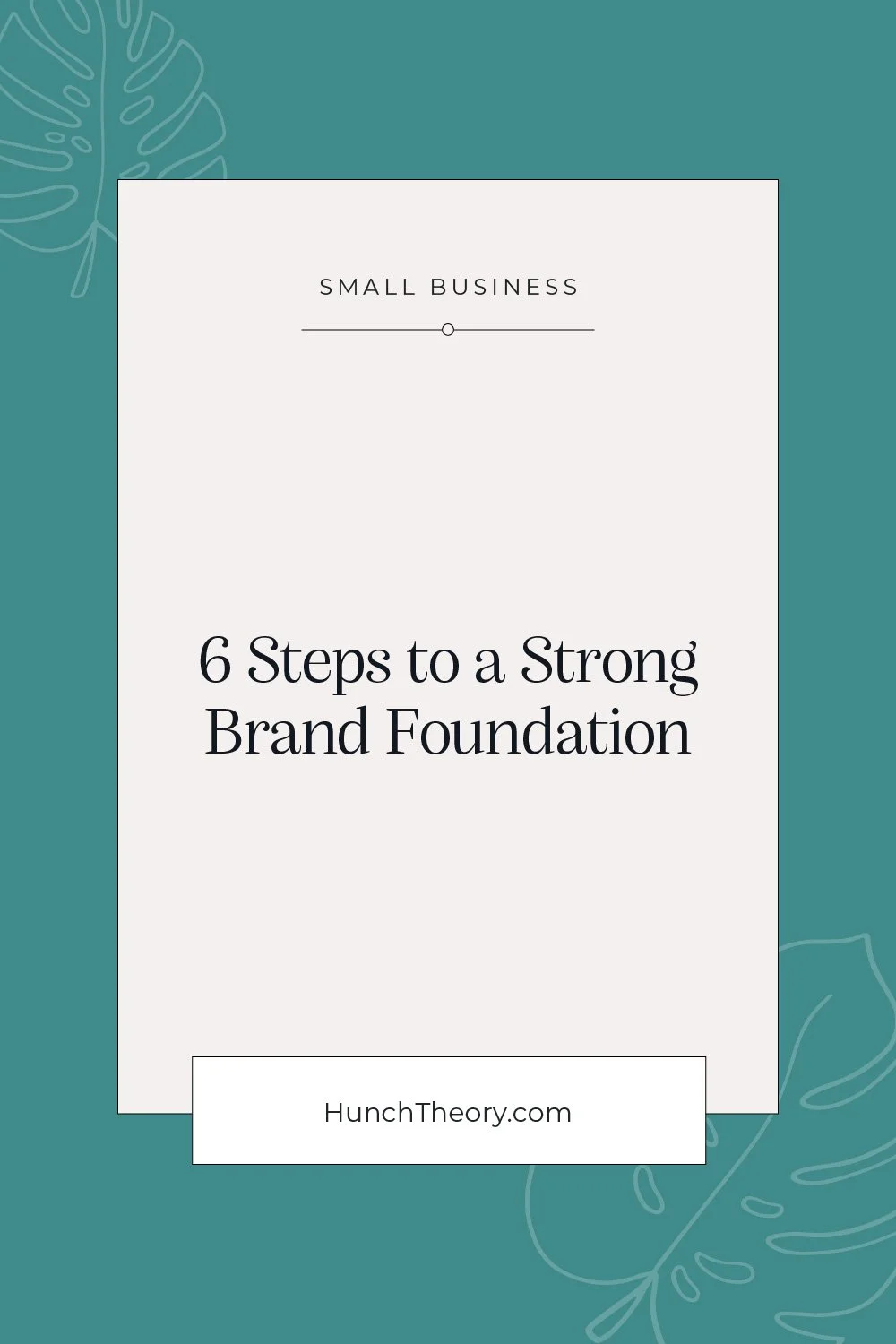6 Steps to a Strong Brand Foundation
WHAT EXACTLY IS A BRAND?
From hashing out your ideal customer to establishing the customer experience you want to offer your clients, branding is about much more than just a logo. So setting a proper brand foundation is crucial to getting off to a good start.
When I think of “foundation” I think of the foundation of a house. People tend to get all excited about architecture, paint colors, and interesting elements like crown molding and hardwood floors. But rarely do people get jazzed up about what a nice foundation your house has. Still, there’s no denying that it’s an essential part of a good house and we all know that foundation issues are the worst!
YOUR BRAND FOUNDATION
So, when it comes to your business, having a good brand foundation set, can make the rest of your sales and marketing more consistent, fluid, and effective. The problem is that taking the time to get it set up well, takes effort and doesn’t lead to immediately satisfying results, so people often like to skip past it. But trust me, you DON’T want to skip this part.
With houses, the foundation can be the costliest to fix. This means that you need to make sure that it’s in a solid-state, and if it’s not, you need to focus on that before going out and doing other renovations.
It’s the same with your business’s brand – not having a proper foundation set up can lead to costly issues down the road – mainly because your marketing is more likely to be off the mark.
Perhaps with your business, you’ve decided that you need to update your website, start advertising, or invest in a marketing campaign. If you hire someone competent, they should ensure that these things are in place BEFORE diving into the work. This can feel like an extra step that you may be tempted to skip, but it’s actually key to making sure that your marketing dollars are spent effectively. Imagine spending big money to have a website made, only to find that you didn’t tell the right story on the website and it left your customers confused.
And if there is one thing I’m sure of, it’s that confusion loses customers.
So, before you jump into any big marketing projects, it’s critically important that you take some time and define your brand. Below I’ll walk you through 6 key elements of your brand’s foundation. I’m going to use a fake hair salon company called A Cut Above as an example so you can see the process illustrated.
1) YOUR IDEAL CUSTOMER
People use the word “target market” a lot in business settings. Your target market is who you are directing your attention to. I’ve had clients tell me that their target customer is anyone who comes to them. While it may be the case that when you’re just getting going, you do take on anyone who wants you, eventually it will benefit you to pay attention to which customers you liked working with best and why. And for the sake of writing effective copy, it’s important to be more specific about who you want to work with.
You may be familiar with the 80/20 principle or Pareto’s principle. In a business setting, it says that 80% of your business or profit comes from 20% of your efforts. I really like this principle for small businesses because let’s face it, we small business managers are often short on time and money, and if we could really hone into where we’re going to get the maximum benefit from the strategically limited effort, that could really help free up some time and resources.
I prefer the term “ideal customer”, to “target market” because it sounds more approachable. It frees you up to really look critically at who you work best with. Who pays the most and has the fewest problems or complaints? The more specific you can get with that, the better it can help you to focus on this ideal customer when building your brand.
Example: A Cut Above is a (fictional) business that specializes in cutting children’s hair. Their ideal customer is parents with children between the ages of 3-10. They serve all genders and are particularly suited to working with children who have maybe had a difficult time at other salons. Because at that age, the parents are the ones making the decision, they cater marketing to the parents.
2) DIFFERENTIATION
This is one of THE MOST IMPORTANT elements of your branding. This is the key to closing sales and bringing your business to the next level. Your differentiation takes what you do (which is probably something that other company’s offer as well) and drills down into what makes your product or service, unlike all the others. What makes your brand better or different? This can tie back into your ideal customer.
Example: A Cut Above is not like other salons. They structure their services to meet their client’s needs. Because they serve children who don’t particularly like getting their hair done, they take extra time just talking to the child and making them feel comfortable before even getting them in the chair. Then they are able to get haircuts done more quickly than the average job and have lots of treats for the child after the hair cut so they leave with it being a positive experience.
3) NICHE (OPTIONAL)
A niche is something that naturally just fits. In architecture, this is often a recess that can fit a statue or a seating area. In business, this can be a segment or area of specialty. This can be part of your Ideal Customer and Differentiation, but I wanted to address it on its own. While you should think about your ideal customer and differentiation ahead of time, your niche may take longer to really flush out. Is there a particular service, need, or customer that you can focus on?
Example: In the case of A Cut Above, special training and experience allow them to do an incredible job working with autistic kids. This is not their full ideal customer as it’s a very narrow field, but it is something they can call out in their messaging, and parents of autistic kids will be especially drawn to them.
4) BRAND PROMISE
The key here is to start by figuring out the clear value that you bring to your customer and making sure this value is delivered consistently before, during, and after working with you. Think about what your ideal customer is needing most from you. Your brand promise is the expectation of an experience that customers should look to you for. Try to focus in on just a few things. Think about how will your customer’s life improve as a result of working with you? How will they feel? What will be different? Once you’ve defined your value, then you take that value and turn it into your brand promise. Everything in your marketing should align with this brand promise. It’s important to communicate these things because they’re not always apparent.
Example: For A Cut Above, the value we seek to give their customers is less stress. Our brand promise is that we will take the time to establish a connection with the child first, which allows parents to relax and take a step back. You can imagine how this can be communicated in different ways throughout their copywriting. A Cut Above takes the stress out of getting your child’s haircut and turns it into an enjoyable experience for both you and your child.
5) CONSISTENT IDENTITY
This is the part that most people think about when we talk about branding, especially your brand’s logo. Many small businesses don’t have a set logo because they think that it needs to be an expensive investment. While yes, you can pay big bucks for a logo, and I do think that can be valuable for some brands – but for many small businesses, a simple logo can still be great, especially if it follows some basic logo guidelines. Your logo needs to be consistent to communicate something about your business to your customers. A wordmark logo is a great place to start. Choosing good fonts for your logo will set you up for a beautiful brand that you don’t outgrow quickly.
But in addition to the logo, you should also consider your fonts, color scheme, even the tone of voice you use in your copywriting to all be part of your brand identity. All of this should be done with your ideal customer in mind. Your brand identity should influence the look and feel of your storefront or offices, your website, and all other customer touchpoints.
Example: For A Cut Above, their logo is whimsical with bright, bold colors, which they also incorporate tastefully throughout their salon, carefully balance it out with calm and order so as to not to overwhelm the senses. Because they keep their colors bright, their fonts are clean and simple, and their copywriting tone is casual and to the point.
6) CUSTOMER EXPERIENCE
Think about what experience is important to your customer. Going back to the value that you offer, and your brand promise, how can those be factored in here? What is the expectation of experience that you want to offer? What will help your customers to let down their guard and trust you to deliver on your brand promise? Part of your branding could be above and beyond service, or organization, or attention to detail. You need to find multiple ways to reiterate these elements into your customer’s experience.
Example: A Cut Above markets to the parents, but when kids walk through the door, they become the customer. Stylists speak directly to the child and treat them with confidence and respect. Each stylist chair also has an area for the parent, or the parents have an area where they can relax in the waiting room which has parent magazines and toys, and entertainment for other children.
Branding is about so much more than what people see... it's about how you make people feel.
- Kimberly Haydn
You can read more about each of these topics in future blog posts, but getting the brand foundation set is so key to the rest of your marketing. I’d encourage you to spend some time with this working through your own brand’s foundation, as it will help immensely with the rest of your marketing.
And once you’ve worked your way through setting a good brand foundation, a great next step is to go and set up Google My Business, so your business is seen and verified by Google.







